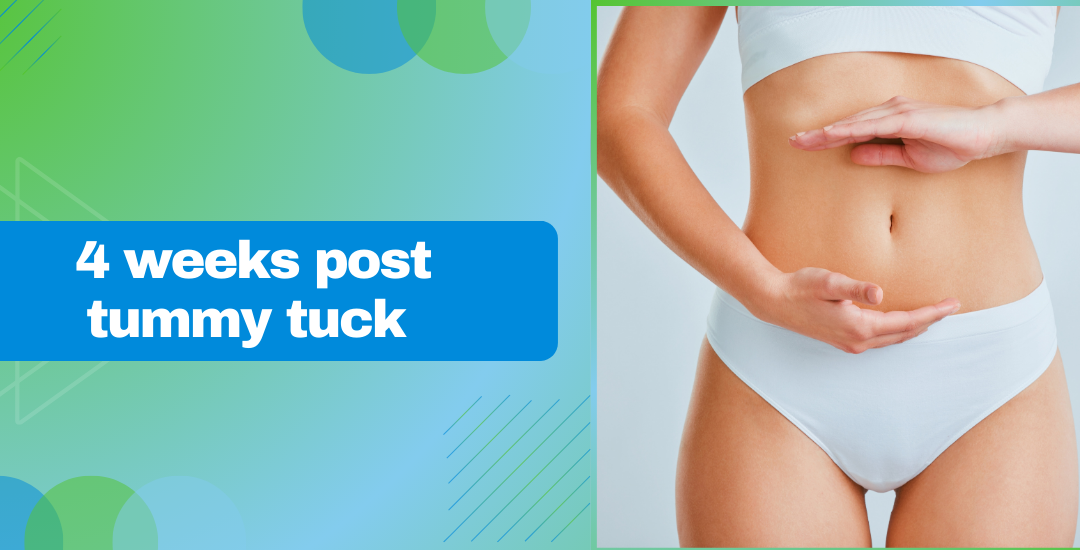Curious if your recovery is progressing well. Consult with a seasoned expert to ensure you’re on the right path.Book your appointment now!
What to Expect 4 Weeks After Tummy Tuck
At 4 weeks post tummy tuck, your body will have made significant progress in healing. However, there are still important things to monitor:
- Swelling: Swelling, especially in the lower abdomen, is normal and can last several weeks.
- Pain: 4 weeks post tummy tuck pain and discomfort have reduced. However, mild pain or sensitivity around the incision area may persist.
- Scar Formation: The incision scars may appear reddish or darker. Following your surgeon’s advice on scar care is essential to ensure they heal properly over time.
- Follow-Up Appointments: Regular follow-ups are crucial to monitor your healing process. Your surgeon may adjust your care plan based on your progress.
Are you experiencing any unusual side effects? Let’s discuss how to manage them effectively.
Side Effects and How to Manage
Even though a tummy tuck can deliver impressive results, it’s essential to be aware of potential side effects and how to manage them:
- Residual Swelling: Ice packs and elevating the area can help reduce 4 weeks post op tummy tuck swelling.
- Pain Management: OTC pain medications are typically sufficient to manage discomfort. However, follow your surgeon’s advice regarding pain relief to avoid complications.

- Scarring: The appearance of a tummy tuck scar 4 weeks post op can vary depending on individual healing processes. Silicone sheets or gels can effectively reduce the prominence of scars over time.
- Bruising: Any remaining bruising should be minimal but may still be visible. Gentle massages around the affected area, as recommended by your surgeon, can help with this.
- Itching: Itching around the scar is a common sign of healing. Applying a soothing lotion can help ease discomfort.
- Numbness: At this stage, it’s normal to experience numbness around the incision site, which can last several months.
- Infection Risk: Although rare at this stage, monitoring the incision sites for any signs of infection, such as redness or unusual discharge, is crucial. If you notice any concerning signs, consult your surgeon.
Ensure you’re managing your recovery symptoms effectively. Consult a professional for personalized advice.
What are the results at this stage? Let’s explore how your body is adjusting.
Results & Improvements 4 Weeks Post Tummy Tuck
By the 4-week mark, patients typically start to see the initial results of their tummy tuck. However, it takes time for the full results to become apparent. Here’s what you can expect:
The abdomen usually appears flatter and more contoured, but some swelling may obscure the final results. Patience is crucial as the body continues to heal and settle into its new shape.

Many patients notice improvements in posture and comfort as excess skin and fat have been removed, leading to better support for the back and core.
While the complete transformation may take several months, the progress you see at 4 weeks is a good sign of what’s to come. To ensure these results are long-lasting, it is crucial to follow all post-op guidelines and attend follow-up appointments.
Recovery
What steps should you take to support your recovery? Let’s go over the post-op instructions.
Post Op Guidelines
Following post-operative guidelines is crucial to ensure the best outcome from your tummy tuck. Here’s what you should be doing 4 weeks post-op:
- Wound Care:
Monitor the incision sites for any signs of infection and keep them clean and dry. Your surgeon may recommend specific ointments or treatments to aid in healing.
- Compression Garments: Wear compression garments as directed by your surgeon to reduce swelling and support the abdominal area during the healing process.
- Scar Management: Use prescribed scar treatment to aid in scar healing. Protect your scar from sun exposure to prevent discolouration.
- Physical Activity: Light activities like walking are encouraged, but exercises that strain the abdominal muscles should be avoided. Check with your surgeon before resuming more intense physical activities.

- Hydration and Nutrition: Follow a balanced, nutrient-rich diet to support healing. Avoid smoking and alcohol, as they can hinder recovery.
Conclusion
Understanding the recovery process 4 weeks post tummy tuck is crucial for achieving the best results. The journey from surgery to recovery can be challenging, but with the proper guidance and care, you can navigate this period successfully. Dr. Leena Jain, a renownedplastic surgeon in Bandra, is committed to helping her patients achieve their desired outcomes with minimal complications.
Need more information about your recovery? Schedule your consultation with a specialist to stay on track with your healing.
Do you still have questions about tummy tuck recovery? Let’s answer some of the common queries.
Frequently Asked Questions
What is more painful, tummy tuck or liposuction?
A tummy tuck is generally more invasive and may cause more discomfort than liposuction, but pain levels vary for each individual.
Can I lay flat 4 weeks after tummy tuck?
It’s advisable to avoid laying completely flat for extended periods to prevent strain on the incision sites. One needs to be active, up and about. Consult your surgeon for personalized advice.
Are you still swollen 4 weeks after tummy tuck?
How should a tummy tuck scar look after 4 weeks?
The scar will still be healing and may appear red or slightly raised. With proper care, it will gradually fade over time.
Disclaimer: This page provides information about the recovery process following a tummy tuck and is not intended as a promotion or marketing effort for any specific medical practice.

